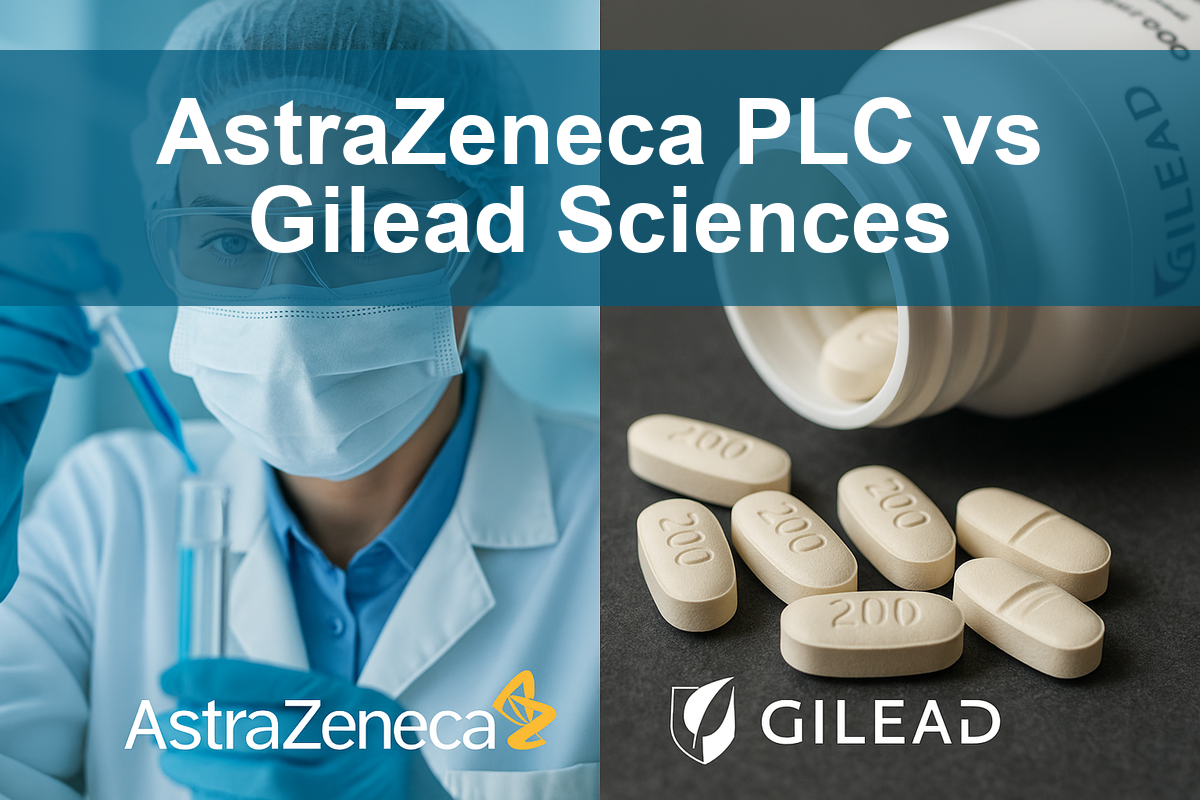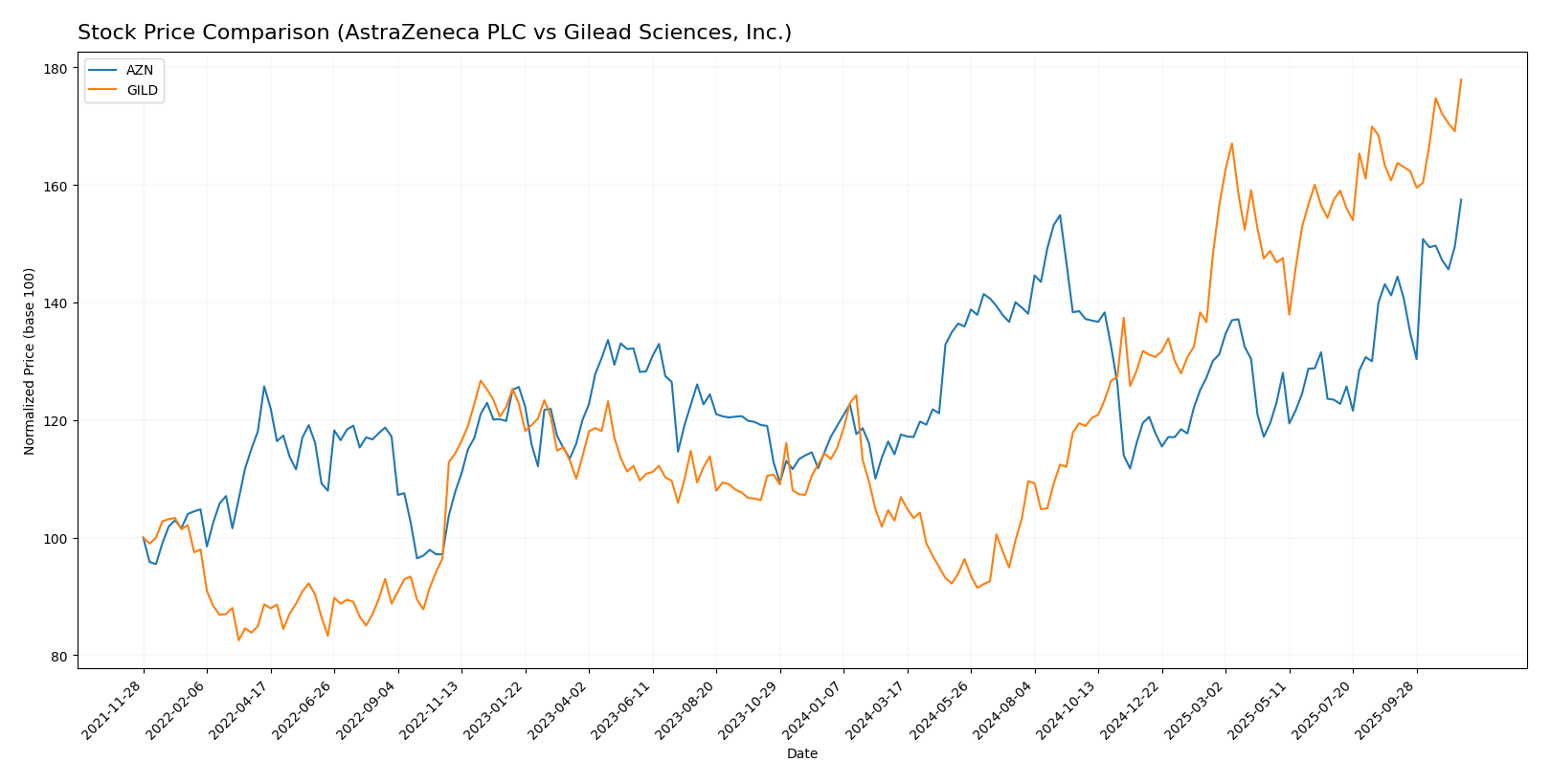In the rapidly evolving biopharmaceutical sector, AstraZeneca PLC (AZN) and Gilead Sciences, Inc. (GILD) stand out as prominent players. Both companies operate in the drug manufacturing space and have a significant overlap in their commitment to addressing critical health needs through innovative treatments. Their distinct approaches to research and development, particularly in oncology and infectious diseases, offer intriguing insights. Join me as I delve into a comparative analysis to identify which company might be the more compelling investment opportunity for your portfolio.

Table of contents
Company Overview
AstraZeneca PLC Overview
AstraZeneca PLC, headquartered in Cambridge, UK, is a leading biopharmaceutical company that focuses on the discovery, development, manufacturing, and commercialization of innovative prescription medicines. The company specializes in areas such as oncology, cardiovascular, renal, and respiratory diseases, offering a diverse portfolio of products, including Tagrisso, Imfinzi, and Vaxzevria. AstraZeneca’s mission is to push the boundaries of science to deliver life-changing medicines to patients around the globe. With a market cap of $287.5B and a workforce of approximately 94,300 employees, AstraZeneca is well-positioned in the healthcare sector, showcasing strong growth potential through collaborations and advanced drug discovery initiatives.
Gilead Sciences, Inc. Overview
Gilead Sciences, Inc., based in Foster City, California, is a prominent biopharmaceutical company dedicated to creating innovative medicines to address unmet medical needs. Gilead specializes in therapeutic areas such as HIV/AIDS, liver diseases, and oncology, with key products like Biktarvy, Veklury, and Yescarta. The company’s mission is to improve the lives of patients worldwide with groundbreaking therapies. With a market capitalization of $156.1B and approximately 17,600 employees, Gilead continues to strengthen its market position through strategic collaborations and a robust pipeline of investigational drugs.
Key similarities and differences
Both AstraZeneca and Gilead operate in the biopharmaceutical sector, focusing on innovative drug development for critical healthcare needs. However, AstraZeneca has a broader portfolio that spans multiple therapeutic areas, while Gilead specializes more heavily in HIV/AIDS and oncology. Their collaborative strategies also differ, with AstraZeneca emphasizing advanced drug discovery partnerships, whereas Gilead focuses on developing targeted treatments for specific diseases.
Income Statement Comparison
The following table provides a comparative overview of the latest income statements for AstraZeneca PLC (AZN) and Gilead Sciences, Inc. (GILD), highlighting key financial metrics.
| Metric | AstraZeneca (AZN) | Gilead Sciences (GILD) |
|---|---|---|
| Market Cap | 287.48B | 156.13B |
| Revenue | 54.07B | 28.75B |
| EBITDA | 15.44B | 4.43B |
| EBIT | 10.37B | 1.67B |
| Net Income | 7.04B | 0.48B |
| EPS | 1.14 | 0.38 |
| Fiscal Year | 2024 | 2024 |
Interpretation of Income Statement
In 2024, AstraZeneca demonstrated strong revenue growth, reaching 54.07B, a significant increase from 45.81B in 2023. Gilead, while also experiencing growth to 28.75B from 27.12B, showed slower momentum compared to AstraZeneca. Both companies maintained healthy margins, but AstraZeneca’s EBITDA margin of about 28.6% highlights its operational efficiency compared to Gilead’s 15.4%. Gilead’s net income of 0.48B indicates a challenging year, reflecting its focus on R&D and marketing expenses. Overall, AstraZeneca’s robust performance underscores its market leadership in biopharmaceuticals, while Gilead must address its profitability concerns moving forward.
Financial Ratios Comparison
The following table provides a comparative overview of key financial ratios for AstraZeneca PLC (AZN) and Gilead Sciences, Inc. (GILD) based on the most recent data.
| Metric | AstraZeneca (AZN) | Gilead Sciences (GILD) |
|---|---|---|
| ROE | 17.25% | 2.48% |
| ROIC | 10.30% | 2.36% |
| P/E | 28.87 | 17.85 |
| P/B | 4.98 | 4.43 |
| Current Ratio | 0.93 | 1.60 |
| Quick Ratio | 0.74 | 1.45 |
| D/E | 0.74 | 1.09 |
| Debt-to-Assets | 28.95% | 40.22% |
| Interest Coverage | 5.95 | 8.06 |
| Asset Turnover | 0.52 | 0.44 |
| Fixed Asset Turnover | 4.64 | 5.31 |
| Payout Ratio | 65.80% | 67.24% |
| Dividend Yield | 2.28% | 3.77% |
Interpretation of Financial Ratios
AstraZeneca exhibits higher returns on equity (ROE) and invested capital (ROIC) compared to Gilead, indicating stronger profitability. However, Gilead shows a more favorable current and quick ratio, reflecting better short-term liquidity. The debt-to-assets ratio is substantially higher for Gilead, raising potential concerns about financial leverage. Overall, while AstraZeneca appears robust in profitability metrics, Gilead’s liquidity and lower P/E ratio may suggest a value opportunity.
Dividend and Shareholder Returns
AstraZeneca PLC (AZN) pays dividends with a current yield of 2.28% and a payout ratio of approximately 66%. The dividend per share has shown stability, backed by solid free cash flow, although risks include potential unsustainable distributions. Conversely, Gilead Sciences, Inc. (GILD) also provides dividends, offering a higher yield of 3.67% and a payout ratio of about 67%. Both companies engage in share buyback programs, which can enhance shareholder returns. Overall, their distributions support long-term value creation, albeit with attention to sustainability.
Strategic Positioning
AstraZeneca PLC (AZN) holds a significant market share within the biopharmaceutical sector, particularly in oncology and cardiovascular treatments, supported by a robust product portfolio. Gilead Sciences, Inc. (GILD) competes strongly in antiviral therapies, especially HIV and COVID-19 treatments, but faces competitive pressure from emerging biotechs and generics. Both companies are navigating technological disruptions, with increased focus on AI-driven drug discovery and personalized medicine, which could reshape their market positioning in the near future.
Stock Comparison
In this section, I will analyze the weekly stock price movements of AstraZeneca PLC (AZN) and Gilead Sciences, Inc. (GILD) over the past year, highlighting key price dynamics and notable trends.

Trend Analysis
AstraZeneca PLC (AZN) Over the past year, AZN has experienced a significant price increase of 35.6%. This bullish trend is characterized by acceleration, indicating strong upward momentum in the stock. The price fluctuated between a high of 92.72 and a low of 62.26, suggesting a standard deviation of 6.87, which indicates moderate volatility. In the recent period from September 14, 2025, to November 30, 2025, AZN has shown a price increase of 16.54% with a standard deviation of 5.33, further confirming the acceleration in its trend.
Gilead Sciences, Inc. (GILD) Similarly, GILD has demonstrated a robust bullish trend with a 51.05% increase over the past year. This stock has also shown acceleration, reflecting strong demand. The price range has been 126.64 at its peak and 64.27 at its lowest point, with a higher volatility indicated by a standard deviation of 18.65. In the recent analysis period from September 14, 2025, to November 30, 2025, GILD’s price rose by 9.86% with a standard deviation of 4.95, highlighting continued interest in the stock.
In conclusion, both AZN and GILD are experiencing strong bullish trends with notable price increases and signs of acceleration, making them compelling options for investment consideration in the current market environment.
Analyst Opinions
Recent analyst recommendations indicate a generally positive outlook for AstraZeneca PLC (AZN) and Gilead Sciences, Inc. (GILD). Analysts have rated AZN with a B+, citing strong return on equity and assets, although they note a relatively high debt-to-equity ratio. Conversely, GILD received an A- rating, praised for its excellent discounted cash flow and return metrics. Overall, the consensus for AZN is a hold, while GILD is trending towards a buy for the current year.
Stock Grades
In today’s market, I have gathered some insightful stock ratings for two prominent companies: AstraZeneca PLC and Gilead Sciences, Inc.
AstraZeneca PLC Grades
| Grading Company | Action | New Grade | Date |
|---|---|---|---|
| UBS | upgrade | Buy | 2025-02-13 |
| UBS | upgrade | Neutral | 2024-11-20 |
| Erste Group | upgrade | Buy | 2024-09-11 |
| TD Cowen | maintain | Buy | 2024-08-12 |
| Argus Research | maintain | Buy | 2024-05-30 |
| BMO Capital | maintain | Outperform | 2024-04-26 |
| Deutsche Bank | upgrade | Hold | 2024-04-16 |
| BMO Capital | maintain | Outperform | 2024-02-12 |
| Deutsche Bank | downgrade | Hold | 2024-02-08 |
| Jefferies | downgrade | Hold | 2024-01-03 |
Gilead Sciences, Inc. Grades
| Grading Company | Action | New Grade | Date |
|---|---|---|---|
| Needham | maintain | Buy | 2025-11-13 |
| Truist Securities | maintain | Buy | 2025-11-03 |
| JP Morgan | maintain | Overweight | 2025-10-31 |
| Needham | maintain | Buy | 2025-10-31 |
| Wells Fargo | maintain | Overweight | 2025-10-31 |
| RBC Capital | maintain | Sector Perform | 2025-10-31 |
| Cantor Fitzgerald | maintain | Overweight | 2025-10-31 |
| TD Cowen | maintain | Buy | 2025-10-23 |
| Citigroup | maintain | Buy | 2025-10-08 |
| JP Morgan | maintain | Overweight | 2025-09-16 |
Overall, AstraZeneca has shown a positive trend with multiple upgrades to “Buy,” indicating growing confidence from analysts. Gilead Sciences also maintains a strong position with consistent “Buy” and “Overweight” ratings, suggesting solid investor sentiment. As always, I advise considering these grades in conjunction with your investment strategy and risk tolerance.
Target Prices
A consensus target price has been established for both AstraZeneca PLC (AZN) and Gilead Sciences, Inc. (GILD), reflecting analysts’ expectations for these companies.
| Company | Target High | Target Low | Consensus |
|---|---|---|---|
| AstraZeneca PLC | 97 | 97 | 97 |
| Gilead Sciences, Inc. | 147 | 105 | 130.4 |
For AstraZeneca, analysts expect the stock to reach a target consensus of 97, closely aligned with its current price of 92.72. In contrast, Gilead’s consensus of 130.4 suggests an upside potential compared to its current price of 125.84, indicating a generally positive outlook.
Strengths and Weaknesses
The following table outlines the strengths and weaknesses of AstraZeneca PLC (AZN) and Gilead Sciences, Inc. (GILD) based on their most recent performance metrics.
| Criterion | AstraZeneca PLC (AZN) | Gilead Sciences, Inc. (GILD) |
|---|---|---|
| Diversification | Strong portfolio across multiple therapeutic areas | Focused on antiviral and oncology markets |
| Profitability | Net profit margin of 13.01% | Net profit margin of 20.89% |
| Innovation | High R&D investment and numerous collaborations | Strong focus on drug development for unmet needs |
| Global presence | Operates in over 100 countries | Strong presence in the U.S. and Europe |
| Market Share | Significant in oncology and respiratory | Strong in HIV and liver diseases |
| Debt level | Debt to equity ratio of 0.73 | Debt to equity ratio of 1.38 |
Key takeaways: AstraZeneca shows strong diversification and innovation, while Gilead excels in profitability and market share. However, Gilead’s higher debt level indicates greater financial risk.
Risk Analysis
In this section, I outline the key risks associated with AstraZeneca PLC (AZN) and Gilead Sciences, Inc. (GILD) to help investors make informed decisions.
| Metric | AstraZeneca (AZN) | Gilead Sciences (GILD) |
|---|---|---|
| Market Risk | Moderate | High |
| Regulatory Risk | High | Moderate |
| Operational Risk | Moderate | Low |
| Environmental Risk | Moderate | Moderate |
| Geopolitical Risk | High | Moderate |
Both companies face significant regulatory risks due to the nature of their industries. Recent changes in healthcare regulations can lead to increased compliance costs. Market risk for Gilead is heightened by its reliance on a few key products, exposing it to sales volatility.
Which one to choose?
When comparing AstraZeneca PLC (AZN) and Gilead Sciences, Inc. (GILD), both companies show bullish stock trends, with AZN’s price increasing by 35.6% and GILD’s by 51.05%. GILD boasts a higher overall rating of A- compared to AZN’s B+, reflecting stronger fundamentals, particularly in return on equity and assets. GILD has a lower price-to-earnings ratio (17.85) than AZN (28.87), suggesting better value for growth-focused investors. Additionally, GILD’s current ratio (1.60) indicates stronger liquidity compared to AZN (0.93).
Investors looking for growth opportunities may prefer GILD, while those prioritizing stability and solid fundamentals might favor AZN.
Both companies face risks related to competition and dependence on market conditions, which could impact future performance.
Disclaimer: This article is not financial advice. Each investor is responsible for their own investment decisions.
Go further
I encourage you to read the complete analyses of AstraZeneca PLC and Gilead Sciences, Inc. to enhance your investment decisions:



